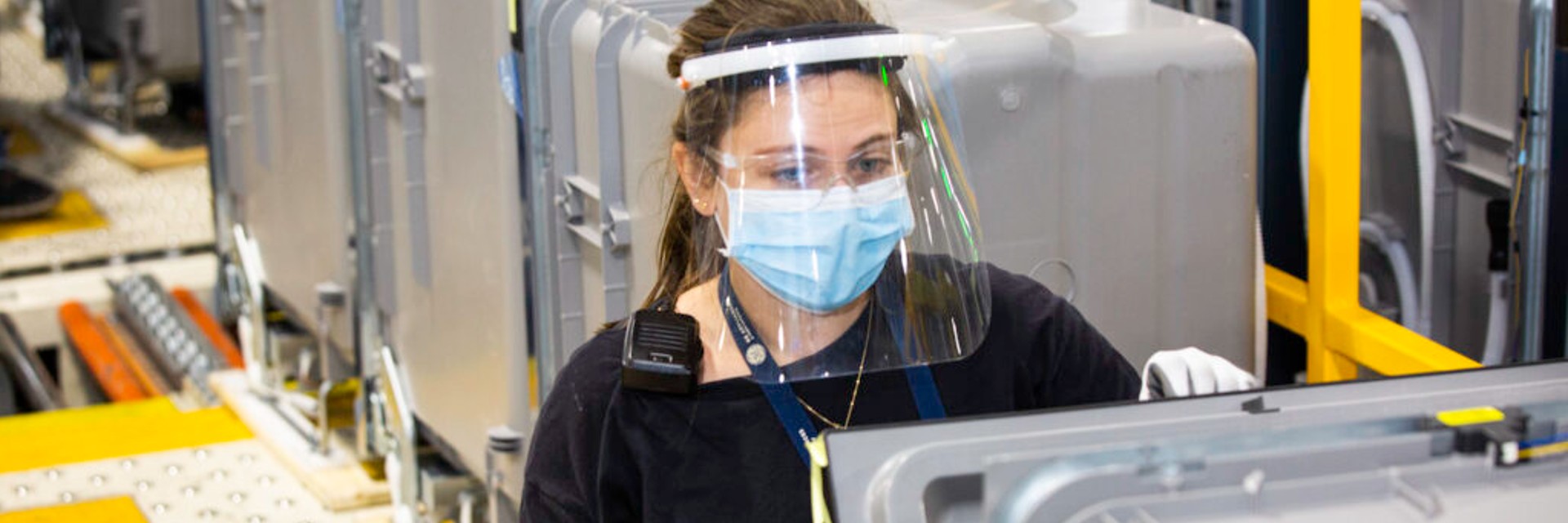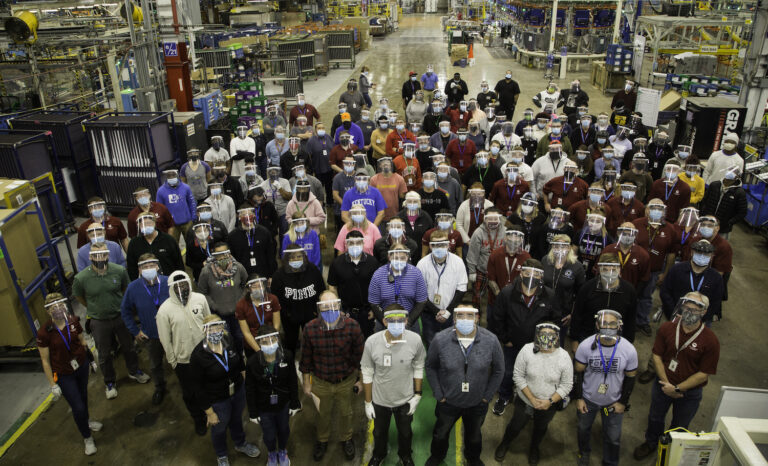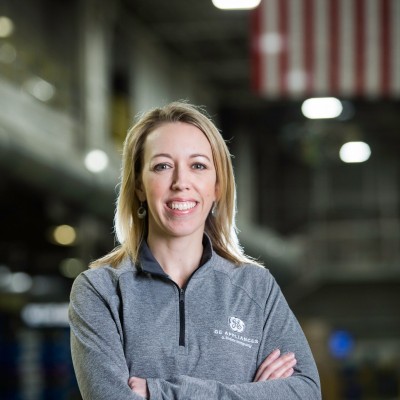Sparring about your Lean issue?
Call René
In 2020, GE Appliances had to set up a brand new assembly process for a new dishwasher. The manager in charge of the program explains how Lean Product & Process Development helped them get it right.
Interviewee: Alison Seward, Executive Director, Manufacturing Quality, GE Appliances
In 2020, you led a very successful project to set up a production system and launch a new product at GE Appliances. Can you give us some context?
I led an $80 million investment in our dishwasher product line, which is part of our kitchen cleaning business. Not only did we develop a new dishwasher, but we also had to design and set up a new assembly process. Because we had to install all this in a plant that was already in production, we often joked that it was like changing the tires on your car as you drive it along. As if that wasn't challenging enough, our launch date was November 2020, meaning we had to test and install much of our equipment during the worst months of the pandemic.
What was your first step?
One of the first things I did when I joined the project was to restructure the way the team worked. We were very focused on our functional silos - design, quality, the commercial team, and so on. Their work was very separate. With this challenge, we had to do things differently. So I rearranged the team, physically. I asked people to move their desks, and we moved the whole office. It was an unpopular move at first, but it was important that we disrupt the status quo.
I knew that for success, we needed people who thought outside their functional areas. Of course we needed the depth of their functional expertise, but we also wanted them to consider the impact of their work on the larger project. Silos aren't bad in themselves, but you can't get stuck in them. You have to be able to work outside of them.
You say the decision to transfer people was unpopular. How did you manage that transition?
The team was fantastic at trying out the new system, but it required a lot of heavy coaching and mentoring in the beginning because it was a different process and principles. It wasn't necessarily that people were resisting, it was just that the system was new to them. It is normal for us humans to resist change at first, so it took a lot of energy and effort in the beginning to transform the team and train them in a different way of working.
I got a lot of support from all the functional leaders in the product line, who supported the change. I really want to express my great appreciation to the team, who took all my crazy ideas and ran with them. In the end, they understood the challenge and why I proposed the change.

Wasthis the first introduction to Lean Product & Process Development principles and practices for the team involved in this project?
For most of them, yes. We had done a lot of Lean Product & Process Development work around the different product groups, but it hadn't really penetrated the dishwasher, or at least not for a long time. A lot of people on the team were not familiar with it. We provided a lot of training and other development opportunities to close that gap. For example, I took my design manager to one of our Lean Product & Process Development learning partner sessions to see how we could effectively teach people these ideas. I also arranged a training session with my team with John Drogosz of the Lean Enterprise Institute, to get someone else to talk about these principles instead of just me.
What were the key milestones in the installation process of the new system?
We started by really understanding the work. Everyone on the program team went to our existing assembly lines and worked there. We were, of course, strategic about where we placed people. For example, our advanced manufacturing engineers, the people who design our equipment, were asked to do some of the most physically demanding jobs, in the hopes that they would come up with ideas on how to do those jobs better on the new line. So we really started giving everyone that insight into the work on the line. We coupled that with basic training on standardized work for everyone on the team so that we could have conversations about the more technical aspects of Lean.
From there, it was an iterative process of looking at the layout from an equipment and work perspective. We were fortunate that seven of our team leaders, who were part of our hourly wage staff, would be the team leaders on the new assembly line when it started. We had brought them into the program about a year and a half in advance, and they were responsible for understanding how the work on the line would be classified. We could then link that to the equipment layout. It was an ongoing iterative process to find a common solution where we had a good equipment layout and a good work structure for the workers.
At Lean Product & Process Development, most people think of product development. But there is another part, which is process design. In your experience, what are the challenges of the process development part?
When the process is new, you don't know what you don't know, and that can be dangerous. For this dishwasher project, we built a recreated assembly line (we called it our dojo), with different conveyors that we could move in and out to simulate different parts of the line. We could speed them up and slow them down. We sometimes made fixtures out of Styrofoam. Basically we tried things out (things can look good on paper or in your head, but until you try them out you don't know). With those experiments, we learned hard lessons. If a configuration didn't work, we had to go back and try again. The most important thing was to learn what didn't work when we used Styrofoam and 3D printed parts, as opposed to when we had steel on the floor and parts from production tools. We tried to find problems early on. This is really the main advantage of Lean Product & Process Development over traditional manufacturing and process development: you will eventually find the problems, but it's much better to find them when they don't cost you a lot of rework and money.

Youhave configured the conveyor belt as a fishbone. Can you explain what that looks like?
The different bones represented different parts of the product - the tub, the door rack, and so on - and they fed the main process, represented by the backbone of the fish. We structured the teams around these "bones," so they had autonomy over many considerations within their fish backbone area, as long as it did not spill over to another group.
Which Lean Product & Process Development techniques and tools proved most useful in this project?
We had quite a few. I already mentioned the mock-ups, which were very important in designing the new process. We also had an Obeya, a super important puzzle piece for the team. All the relevant information hung on the walls and everyone could always access it. Our program leadership was also in the Obeya, so they were always available to the team. Really, the Obeya was crucial in connecting all the other Lean Product & Process Development practices we relied on.
We had a daily stand-up meeting with the entire program team, of 30 minutes or less. This really set the expectations for the day. On Monday, we reviewed the schedule, using a wall that worked as a to-do list for our team, showing what needed to be done when and who was responsible for it (it was also color-coded, making it very visual).
On Wednesdays, we did PDCA with our fishbone teams. For each problem that was identified, we asked people to propose a solution. During the meeting, the teams took turns talking about the major items they were working on or the problems they were trying to solve, asking for help when needed.
Finally, we made decisions on Fridays with our system of "decision diamonds." A few months after starting the program, we realized that we were good at keeping track of individual tasks, but were having trouble knowing if we were on track or not. So we took a step back and started thinking about the critical decisions we needed to make to move forward. The number of decisions to make decreased as we progressed and entered the implementation phase, but in the beginning it was surprising how many we had to make (especially since the pandemic constantly presented us with new challenges).
On Tuesdays and Thursdays, the meeting topics changed depending on where we were in the program cycle.

Whatresults have you been able to achieve?
First, we stayed on schedule even with the pandemic, which is amazing (for the appliance industry, it is incredibly important to release products before Black Friday). We met our product cost targets as well as our sales targets in terms of the price at which we wanted to sell the product. With our investments, we stayed within our budget of $80 million. We also saw an improvement in our star ratings, which reflect the customer's experience with the product. Finally, we had a sold-out assembly line, having started with one shift and added two more since then.
This was quite a project. There is no doubt that the Lean Product & Process Development principles and structure we had in place before the pandemic hit made a successful launch possible.
The interviewee:


Sign up for our newsletter